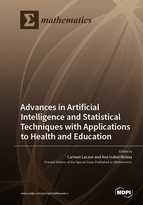Advances in Artificial Intelligence and Statistical Techniques with Applications to Health and Education
A special issue of Mathematics (ISSN 2227-7390). This special issue belongs to the section "Mathematics and Computer Science".
Deadline for manuscript submissions: closed (10 October 2022) | Viewed by 43367
Special Issue Editors
Interests: artificial intelligence; medical expert systems; educational computing; data analysis; Bayesian networks; learning analytics
Special Issues, Collections and Topics in MDPI journals
Interests: human-computer interaction; evaluation of interactive and e-learning systems; eye tracking, educational computing
Special Issues, Collections and Topics in MDPI journals
Special Issue Information
Dear Colleagues,
It is obvious that health and education are the pillars on which social development and well-being are based. However, there are currently many and varied challenges facing these disciplines, which have become even more evident with the COVID-19 pandemic. In this context, the need for a multidisciplinary approach has become especially apparent, which combines both technological advances and different areas related to statistics and artificial intelligence.
Therefore, the proposed Special Issue aims to publish review papers, research articles, and communications, presenting new original methods, applications, data analyses, case studies, comparative studies, and other results, in the fields of medicine or education. Topics will be focused on, but are not limited to, data mining, machine learning, learning analytics, prediction methods, pattern recognition, decision analysis, probabilistic reasoning, fuzzy systems, student or patient modelling, adaptive systems, collaborative systems, recommendation systems, experimental design or empirical study cases.
Prof. Dr. Carmen Lacave
Prof. Dr. Ana Isabel Molina
Guest Editors
Manuscript Submission Information
Manuscripts should be submitted online at www.mdpi.com by registering and logging in to this website. Once you are registered, click here to go to the submission form. Manuscripts can be submitted until the deadline. All submissions that pass pre-check are peer-reviewed. Accepted papers will be published continuously in the journal (as soon as accepted) and will be listed together on the special issue website. Research articles, review articles as well as short communications are invited. For planned papers, a title and short abstract (about 100 words) can be sent to the Editorial Office for announcement on this website.
Submitted manuscripts should not have been published previously, nor be under consideration for publication elsewhere (except conference proceedings papers). All manuscripts are thoroughly refereed through a single-blind peer-review process. A guide for authors and other relevant information for submission of manuscripts is available on the Instructions for Authors page. Mathematics is an international peer-reviewed open access semimonthly journal published by MDPI.
Please visit the Instructions for Authors page before submitting a manuscript. The Article Processing Charge (APC) for publication in this open access journal is 2600 CHF (Swiss Francs). Submitted papers should be well formatted and use good English. Authors may use MDPI's English editing service prior to publication or during author revisions.
Keywords
- Artificial intelligence
- Advanced statistical techniques
- Data mining
- Learning analytics
- Uncertainty
- Learning
- User modelling
- Collaboration
- Adaptation
- Medicine
- Prediction
- Decision







